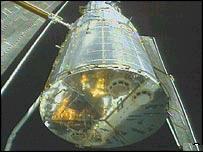A robotic rescue mission to repair and upgrade the Hubble Space Telescope may be feasible, says NASA Assistant Administrator Dr. Ed Weiler.

A robotic rescue mission to repair and upgrade the Hubble Space Telescope may be feasible, says NASA Assistant Administrator Dr. Ed Weiler.
In January, the US space agency said that it is no longer willing to risk astronauts visiting the telescope, and this could limit the telescope's lifespan. However, Dr. Weiler says that there are some promising ideas on how to upgrade the Hubble without a space shuttle. The proposal is to build a small spacecraft that can attach to Hubble. He added that NASA will formulate its decision by June.
It was NASA Administrator Sean O'Keefe who said there would be no more manned flights to Space because they would be too dangerous following the Columbia disaster. Many astronomers were shocked by the fact that such an important telescope, which has many years of operation ahead of it, should be neglected in such a way. Astronauts, astronomers and politicians called on NASA to find ways to save the telescope.
Now, Dr. Weiler's research has managed to bring up some promising ideas as to how an unmanned spacecraft could perform as many of the necessary tasks as possible to keep the Hubble active for a few more years, within the service mission. The telescope's main problem will come when its gyroscopes and batteries stop working. The gyroscopes allow Hubble to point to a precise point and it is necessary to replace or upgrade them, as well as the electric batteries.
The proposal is to send a small spacecraft to attach to Hubble. The spacecraft will be able to connect to Hubble's electrical system and supply it with electricity without having to remove the previous batteries - something that may be a complicated task for a robot. It may also be possible to launch a spacecraft to take over the telescope's pointing capability. But replacing Hubble's optical systems could be a complicated problem for an unmanned mission.
Weiler recently told reporters that he could envision a situation where a new device would be assembled by the robot only partially and could not be repaired. If this happens, it may render the entire device useless. warned
In the coming months, NASA will contact aerospace manufacturers to look for options and offer specific proposals for the Hubble service. The date for carrying out such a mission is in 2007-8 so NASA needs to get subcontractors as early as possible. By the time of the flight there is a high probability that Hubble's remaining gyroscopes will stop working. Engineers are working to develop strategies whereby Hubble will be able to make observations even if additional gyroscopes stop working, but eventually the telescope will have to be shut down pending repairs.
Even if in the end it turns out that Hubble can no longer be saved, it will be necessary to send him a small spacecraft to help him return to the Earth's atmosphere. Due to its size, Hubble cannot be allowed to crash on Earth without control, as its fragments could be dangerous.
For news at the BBC
They knew the satellites
https://www.hayadan.org.il/BuildaGate4/general2/data_card.php?Cat=~~~823716813~~~210&SiteName=hayadan
